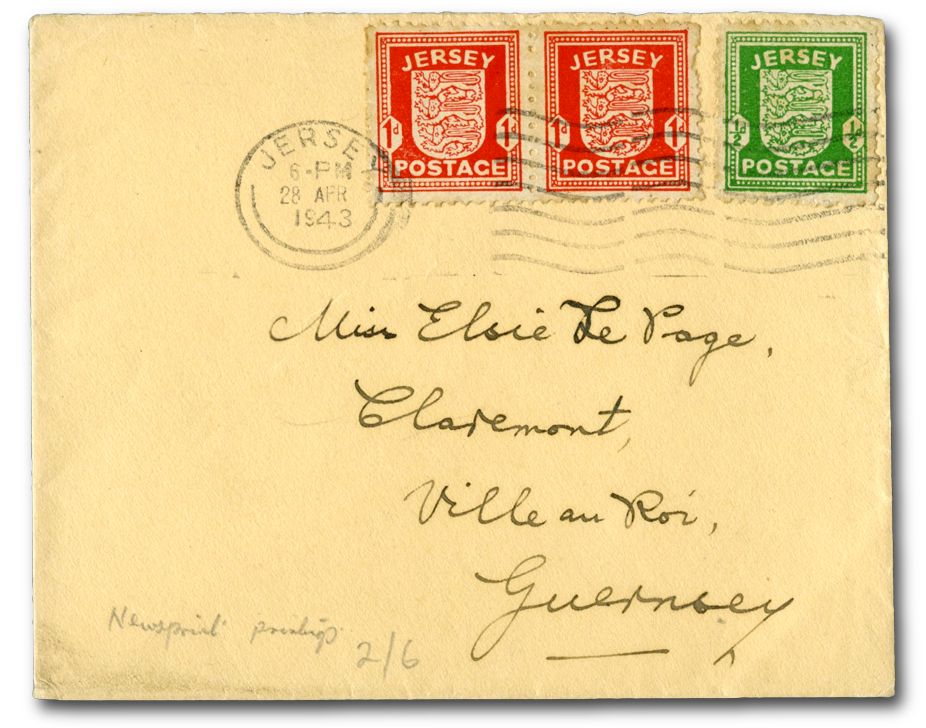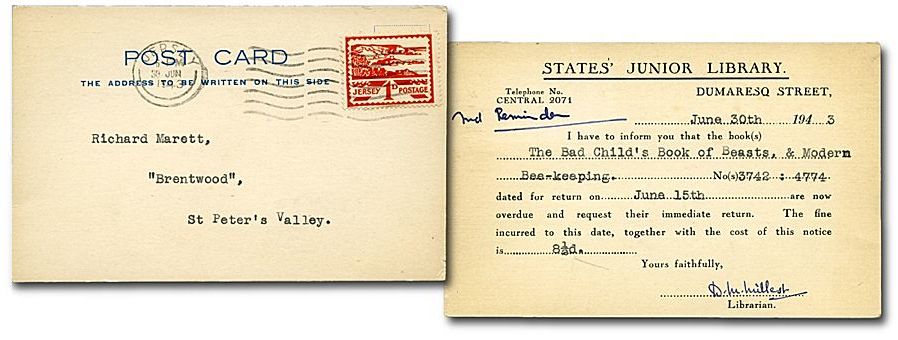The Channel Islands at war — Occupation stamps appear
In 1941, the first “home-grown” Channel Islands occupation stamps appeared. Jersey issued a 1d1 vermillion stamp featuring the Channel Islands Arms on April 1; Guernsey issued a green ½d stamp in a similar design on April 7. Both Jersey and Guernsey subsequently released other stamps in the same designs and different denominations.
Jersey’s stamps were designed by a retired British army officer, artist and historian, Col. Norman Victor Lacey Rybot, and printed by the Jersey Evening Post. Guernsey’s three stamps were designed by E.W. Vaudin, an artist employed by the Guernsey Press Co. Ltd., which printed them. The stamps are notable for their crude designs and poor printing quality. They exist in many shades and were printed on various types of paper, including newsprint.


In 1942, watermarked versions of the two low-value Guernsey stamps were produced. They were printed on blue French banknote paper, have a “chain-link-fence” watermark, and are less common than the earlier versions. Like their predecessors, they too were rouletted 11X7. Unlike their predecessors, they are watermarked with a chain-link design.

Jersey’s Occupation stamps
The first Jersey stamp was based on the design of the Guernsey stamp. When supplies of British postage stamps ran out on Jersey, the Bailiff of Jersey asked Col. Rybot to submit designs for penny and halfpenny stamps. Working from a photograph of the original Guernsey stamp design,2 (which hadn’t yet been issued) and following instructions that the stamps were not to bear the portrait of King George VI or any symbol connecting Jersey with Great Britain (the same instructions that were issued in Guernsey), Rybot produced two trial designs, which were refined to more closely reflect the Medieval style of the original Jersey Arms. German intelligence officers passed the designs for printing.
Jersey’s Occupation stamps
Although the Channel Islands occupation issues are colourful, they certainly don’t meet the high printing standards that the Germans normally applied to most of their other stamp issues. Nevertheless, the occupation stamps supplied an apparent need, and a great many of them were used throughout the war, despite occasional shortages, and for several months after the war as island life gradually returned to normal.
The new occupation stamps didn’t resolve the problems resulting from shortages of basic post office supplies. As you’ve seen previously, Guernsey’s postal workers modified their cancellation hammers for the new year of 1941 by modifying metal type with the numeral “0” of 1940 to look more or less like a “1”. On Jersey, postal workers created other non-standard postmarks that delight today’s postal historians.
The cover below, posted from Jersey to Guernsey by a “Miss Elsie Le Page” and franked with a pair of the Jersey one-penny stamps and a single of the half-penny stamp (the correct rate for inter-island postage), was postmarked on April 28, 1943. Note that the “43” is considerably larger than the “19”. The explanation is that the Jersey postal department had to have new moveable steel type for its cancellation hammers made locally in that year because it couldn’t order steel type from the U.K.

New occupation stamps for Jersey
Between June 1, 1943 and Feb. 25, 1944, Jersey issued a set of six colourful pictorial stamps featuring scenes of Jersey, designed by Edmund Blampied, one of the most eminent artists to come from the Channel Islands. Like Jersey’s and Guernsey’s earlier occupation stamps, Blampied’s stamps were approved by the Germans before being released.


Next, in Part 5: The new Jersey and Guernsey occupation stamps include design elements that serve as symbols of resistance to the German occupation. Channel Islanders are amused, but the German occupation force fails to recognize the significance of the primary designs in the first occupation stamps, or notice the insult implied by minuscule details in all of the stamps.
-
British pre-decimal currency, coins, and stamps were denominated in pounds (£), shillings (/), and pence (d). A pound equals 20 shillings, and a shilling equals 12 pence. The use of the letter “d” to symbolize penny or pence, the plural of penny, comes down to us from the Roman denarius, a small silver coin first minted about 211 BC during the Second Punic War. ↩︎
-
The Jersey occupation stamps show JERSEY in a curved line, because the original Guernsey design showed GUERNSEY in a curved line. Vaudin was ordered to re-design his essay with a straight island-name, but such an order never reached Jersey. ↩︎